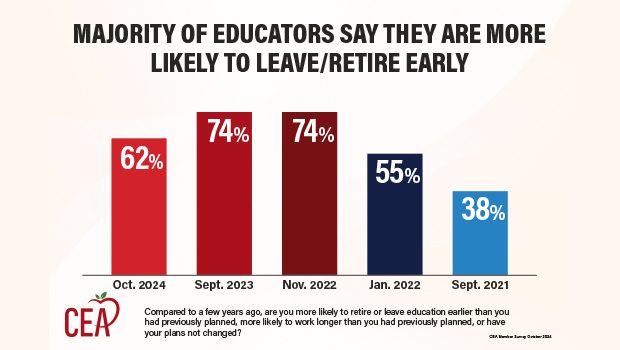New CEA survey finds continuing challenges with student behavioral issues, insufficient pay, and lack of respect contributing to teacher shortage
The Connecticut Education Association (CEA), the state’s largest teachers’ union, today released results from its latest statewide survey, highlighting an ongoing crisis in the teaching profession and the urgent need for greater supports for public education. The survey reveals persistently high levels of frustration, burnout, and job dissatisfaction among Connecticut’s teachers¬—systemic challenges that impact student learning and the teaching profession.
The survey of over 5,000 CEA members statewide, conducted in October, shows that nearly all educators (98%) are concerned about frustration and burnout. When asked to select their five primary concerns, Connecticut teachers identified the following:
- Stress and burnout
- Low salaries
- Student discipline and behavior issues
- Lack of respect for the teaching profession
- Politicians making decisions that affect education
Teachers also named the top five issues contributing to stress and burnout:
- Challenges with student discipline/behavior
- Insufficient pay
- Lack of respect
- Politicians and non-educators making decisions that affect classroom learning
- Too many district initiatives.
“While our continuing advocacy and support for our members has led to improvements in some areas, overall dissatisfaction and stress among teachers remains alarmingly high,” said CEA President Kate Dias. “Our annual survey paints a stark and sobering picture of the teaching profession in Connecticut—one that should serve as a wakeup call for policymakers and communities alike. Our teachers deserve real support, competitive salaries, and respect for their professional expertise.”
Teachers are disillusioned as evident in an alarming 70% of those surveyed saying they would discourage family or friends from entering the teaching profession—a sharp rise from 64% just last year.
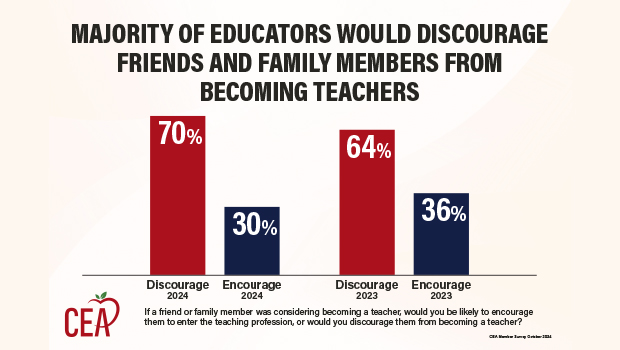
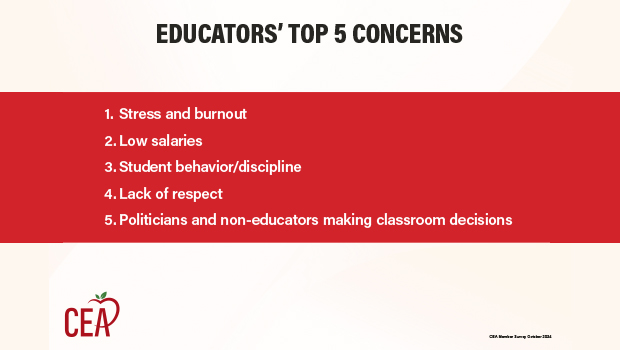
“This trend is especially troubling,” said Dias, “as so many of our educators say it was a teacher who encouraged them to enter the profession. Without those endorsements the teacher pipeline will further erode, and new generations will seek careers with less stress, higher pay, and better working conditions.
While the number of educators planning to retire early or leave the profession has dropped to 62% from 74% in the past two years, it is still a major concern.
“We continue to have a shortage crisis in our state because policymakers have made only minimal efforts to fix the underlying problems,” said CEA Vice President Joslyn DeLancey. “Students don’t want to go into teaching, and educators don’t want their friends and family to go into the profession, because they know there are other careers offering higher pay, less stress, better workplace conditions, greater autonomy, and more flexibility—advantages that teaching currently doesn’t provide but must, in order to make it a competitive and sustainable profession.”
State legislators have made minimal, cost-free efforts to try to improve conditions in our schools, and while we are seeing slight improvements, it’s clear that they fall far short of what’s needed.
“Teachers go the extra mile every single day to ensure their students succeed,” said DeLancey, but the lack of real policy changes and supports is driving even the most dedicated professionals out of the career and classrooms they love. Think about it. Many talented educators have to work two and even three jobs to make ends meet, losing precious time with their own families. These are people with graduate degrees and certification. What does that say about how we value their work and their expertise? It’s time to provide teachers with the salaries they deserve.
CEA is once again calling on the state to do the right thing and align educators’ compensation with the level of education, qualifications, and experience required for the job. In Connecticut, salaries are at least 25% lower for teachers than for other professionals with similar education and experience.
“As a college student preparing to become a teacher, I’m constantly overwhelmed by financial strain,” said Asya Kerr, a senior at Mitchell College who is now student teaching in East Lyme. “Between tuition, books, supplies, and the cost of gas to get to my student teaching placements—which I don’t get paid for—it’s almost impossible to make ends meet. On top of that, I have to work a part-time job. Knowing that my starting salary will barely be enough to live on makes me question how sustainable this career will be.”
Aspiring educator Hannah Spinner, a senior studying at the University of Connecticut, agreed, “So many of my friends are going into other professions because of higher salaries and better working conditions. If we want to attract more students to teaching and adequately employ our school districts, we need to make the profession viable. A $60,000 starting salary would give future teachers like me a chance to focus on what really matters: meeting the needs of those I serve, not my survival.”
“We must take immediate and bold action to invest in educator salaries or risk losing the exceptional teachers Connecticut is known for,” said Dias.
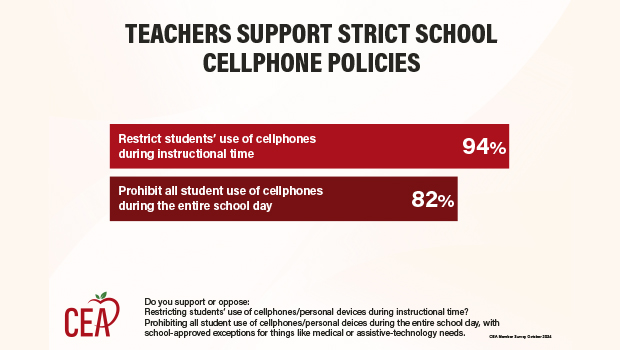
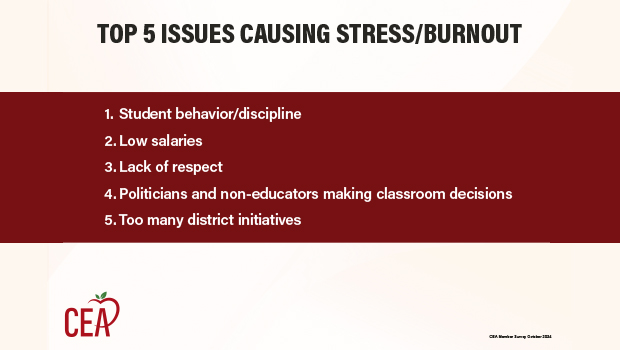
Cellphone Policies and Classroom Management
The survey also looked at teacher perspectives on cellphone policies in schools.
Nearly all teachers (94%) support restricting cellphone use during instructional time, and 82% favor prohibiting devices the entire school day.
“Classroom management challenges, including the use of cellphones, remain a significant hurdle,” said Dias. “Teachers overwhelmingly support stronger cellphone restrictions, reflecting their goal of creating focused, distraction-free learning environments.”
CEA’s Call to Action
CEA is urging state lawmakers and education leaders to address these concerns head-on.
“The future of public education hinges on a teaching profession that is truly valued, well-supported, and sustainable,” said Dias. “We stand ready to work with legislators on solutions to teacher burnout, stress, and low wages. Together we can create conditions that not only encourage current educators to remain in the classroom but also inspire the next generation of students to see teaching as a fulfilling, rewarding, and viable career path.”
Click here for the complete survey.
The survey was conducted by GBAO Strategies October 22-28, 2024. A total of 5,016 Connecticut educators responded to the survey, which has a margin of error of +/- 1.4 percentage points.

